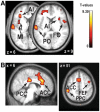An fMRI Study of the Interactions Between the Attention and the Gustatory Networks
- PMID: 25419265
- PMCID: PMC4239214
- DOI: 10.1007/s12078-012-9122-z
An fMRI Study of the Interactions Between the Attention and the Gustatory Networks
Abstract
In a prior study, we showed that trying to detect a taste in a tasteless solution results in enhanced activity in the gustatory and attention networks. The aim of the current study was to use connectivity analyses to test if and how these networks interact during directed attention to taste. We predicted that the attention network modulates taste cortex, reflecting top-down enhancement of incoming sensory signals that are relevant to goal-directed behavior. fMRI was used to measure brain responses in 14 subjects as they performed two different tasks: (1) trying to detect a taste in a solution or (2) passively perceiving the same solution. We used psychophysiological interaction analysis to identify regions demonstrating increased connectivity during a taste attention task compared to passive tasting. We observed greater connectivity between the anterior cingulate cortex and the frontal eye fields, posterior parietal cortex, and parietal operculum and between the anterior cingulate cortex and the right anterior insula and frontal operculum. These results suggested that selective attention to taste is mediated by a hierarchical circuit in which signals are first sent from the frontal eye fields, posterior parietal cortex, and parietal operculum to the anterior cingulate cortex, which in turn modulates responses in the anterior insula and frontal operculum. We then tested this prediction using dynamic causal modeling. This analysis confirmed a model of indirect modulation of the gustatory cortex, with the strongest influence coming from the frontal eye fields via the anterior cingulate cortex. In summary, the results indicate that the attention network modulates the gustatory cortex during attention to taste and that the anterior cingulate cortex acts as an intermediary processing hub between the attention network and the gustatory cortex.
Keywords: Attention; Connectivity; Humans; Insula; Taste; fMRI.
Figures




Similar articles
-
It's in the eye of the beholder: selective attention to drink properties during tasting influences brain activation in gustatory and reward regions.Brain Imaging Behav. 2018 Apr;12(2):425-436. doi: 10.1007/s11682-017-9710-2. Brain Imaging Behav. 2018. PMID: 28321607 Free PMC article.
-
Trying to detect taste in a tasteless solution: modulation of early gustatory cortex by attention to taste.Chem Senses. 2007 Jul;32(6):569-81. doi: 10.1093/chemse/bjm025. Epub 2007 May 10. Chem Senses. 2007. PMID: 17495173
-
The anterior insular cortex represents breaches of taste identity expectation.J Neurosci. 2011 Oct 12;31(41):14735-44. doi: 10.1523/JNEUROSCI.1502-11.2011. J Neurosci. 2011. PMID: 21994389 Free PMC article.
-
Odor/taste integration and the perception of flavor.Exp Brain Res. 2005 Oct;166(3-4):345-57. doi: 10.1007/s00221-005-2376-9. Epub 2005 Jul 19. Exp Brain Res. 2005. PMID: 16028032 Review.
-
Gustatory cortex of primates: anatomy and physiology.Neurosci Res. 1994 Jul;20(1):1-13. doi: 10.1016/0168-0102(94)90017-5. Neurosci Res. 1994. PMID: 7984335 Review.
Cited by
-
Gain in Body Fat Is Associated with Increased Striatal Response to Palatable Food Cues, whereas Body Fat Stability Is Associated with Decreased Striatal Response.J Neurosci. 2016 Jun 29;36(26):6949-56. doi: 10.1523/JNEUROSCI.4365-15.2016. J Neurosci. 2016. PMID: 27358453 Free PMC article.
-
Functional Connectivity of the Chemosenses: A Review.Front Syst Neurosci. 2022 Jun 22;16:865929. doi: 10.3389/fnsys.2022.865929. eCollection 2022. Front Syst Neurosci. 2022. PMID: 35813269 Free PMC article. Review.
-
What can the brain teach us about winemaking? An fMRI study of alcohol level preferences.PLoS One. 2015 Mar 18;10(3):e0119220. doi: 10.1371/journal.pone.0119220. eCollection 2015. PLoS One. 2015. PMID: 25785844 Free PMC article.
-
Localization of the primary taste cortex by contrasting passive and attentive conditions.Exp Brain Res. 2013 Jun;227(2):185-97. doi: 10.1007/s00221-013-3499-z. Epub 2013 Apr 19. Exp Brain Res. 2013. PMID: 23604572
-
Gustatory-Visual Interaction in Human Brain Cortex: fNIRS Study.Brain Sci. 2025 Jan 19;15(1):92. doi: 10.3390/brainsci15010092. Brain Sci. 2025. PMID: 39851459 Free PMC article.
References
-
- Boling W, Reutens DC, et al. Functional topography of the low postcentral area. J Neurosurg. 2002;97(2):388–395. - PubMed
-
- Chun MM, Marois R. The dark side of visual attention. Curr Opin Neurobiol. 2002;12(2):184–189. - PubMed
-
- Corbetta M, Kincade MJ, et al. Neural basis and recovery of spatial attention deficits in spatial neglect. Nat Neurosci. 2005;8(11):1603–1610. - PubMed
Grants and funding
LinkOut - more resources
Full Text Sources
